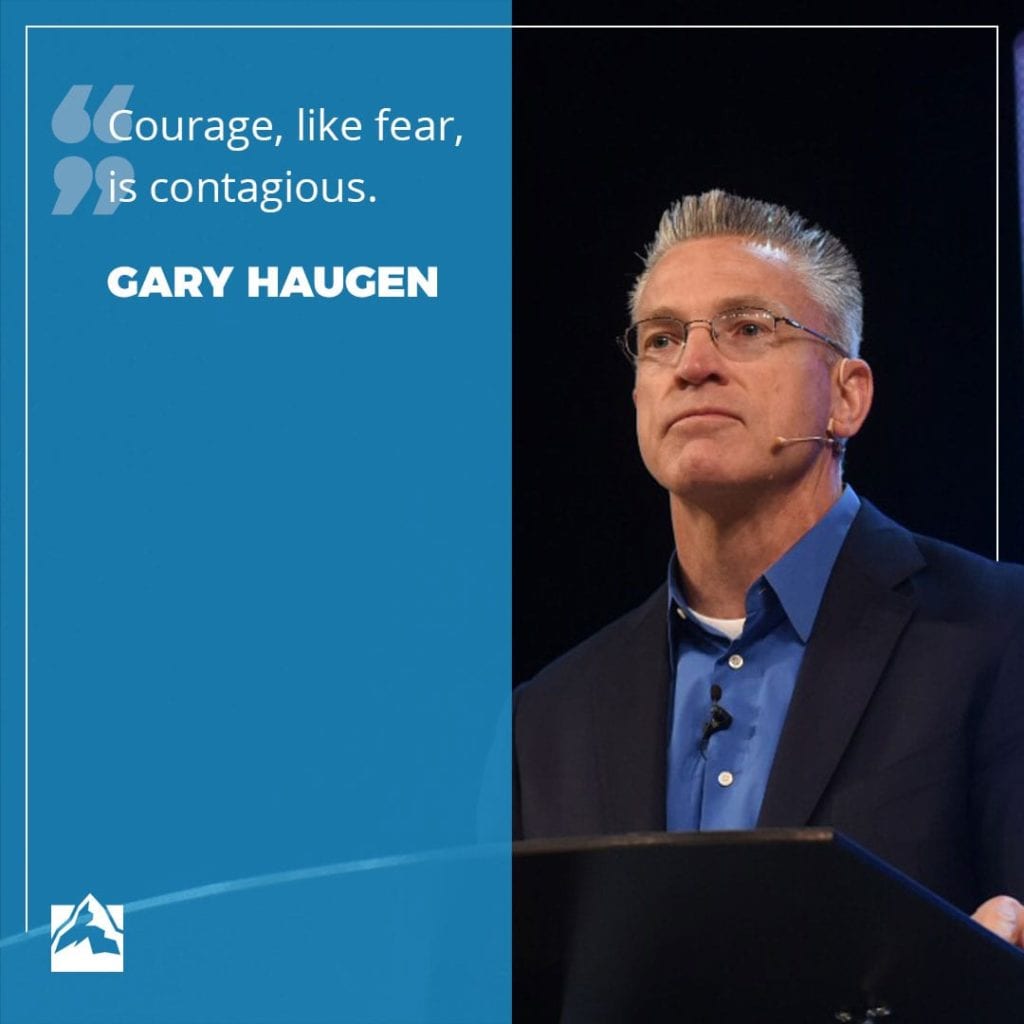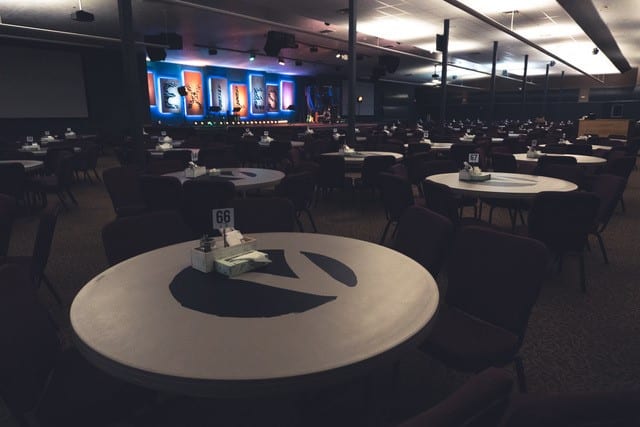Challenge to Be Courageous Changed Our Spectator Church to a Fully Engaged Church
The Summit turned our church upside down.
A local host church in Boise sponsored a team of 10 from our church to attend The Global Leadership Summit for the first-time in 2011. Once we went, we were hooked. I could go to another more expensive conference on my own and try to bring back what I learned to my team with diminishing returns; but what I love about the Summit is that I can take our whole staff locally for the same cost as sending one person to another conference we’d have to fly to. The Summit allows us all to personally engage —everybody grows in their leadership skills. We’re challenged, and we get to do it together.
But we didn’t anticipate how the Summit would turn our church upside down.
But we didn’t anticipate how the Summit would turn our church upside down.
When we attend, we pay attention to two things.
When we attend the Summit, we ask our staff to take notes and pay attention to two things:
- What did YOU need to hear personally for your life, family and ministry?
- What session do WE need to hear as a team leading this church?
When we come back together, the first step we take is to debrief what we learned and determine what stood out the most. Then, using the Team Edition, we revisit those sessions over the next several months.
The year Gary Haugen spoke changed everything.
 The year Gary Haugen spoke was a year when everybody on our team said, I needed to hear that, we needed to hear that. It ended up being the most impactful talk we heard. What stood out was leading out of the God-given dream of what could be—not leading on the defense but leading on the offense—pursuing the dream and what could be and not letting fear be the silent killer of our dream.
The year Gary Haugen spoke was a year when everybody on our team said, I needed to hear that, we needed to hear that. It ended up being the most impactful talk we heard. What stood out was leading out of the God-given dream of what could be—not leading on the defense but leading on the offense—pursuing the dream and what could be and not letting fear be the silent killer of our dream.
Three or four weeks after the Summit, we have our annual vision retreat where a team of our leaders goes away together to seek God for direction and clarity for the coming year. That year, we played Gary Haugen’s talk to marinate in it again and see how God was going to speak to us. It prepared us for where we were going. We made some significant decisions about how we were approaching things. That retreat stands out in all of our minds as really significant and special—we left so energized by what God put on our hearts. He called us to lead out of courage in spite of fears regarding the costs we expected to pay.
We didn’t want to settle for a spectator church experience.
We stepped back, looked at our church and said, Our vision statement is Making the Invisible God Visible. If what we’re called to do is to make disciples and be disciples, are we doing that? Are we satisfied with the results? We could point to anecdotal success, but across the board, we saw a lot of people who were not engaged or were coming to church as spectators.
We didn’t want to settle for a spectator experience, where people come in and listen to a message and then leave.
We wanted to create a more engaged experience of our lives together as a church. We didn’t want to settle for a spectator experience, where people come in and listen to a message and then leave. We wanted to pursue full engagement—and that was across the board. It meant our team had to be more engaged in order to facilitate and model a more engaged experience within the congregation.
The game doesn’t happen in the locker room—it happens on the field.
We use this metaphor: Church is not about what happens on Sunday. Our Sunday gathering is like the half-time locker room during a football game. The game doesn’t happen in the room, it happens on the field. When we come into the locker room, we come in to get bandaged up, coached up, get some nourishment and spiritual Gatorade and revisit the playbook. Then we go back onto the field, because church is about what happens when we leave. Even though we’ve said that a lot, we realized our model didn’t reflect it—the most engaging part of our morning was during our songs of worship. After that, it was primarily a spectator activity.
We had to figure out how to get people more engaged.

We got rid of all the rows of chairs and brought in round tables so people could engage with each other at their tables. We made space within the service for discussion and collaborative exercises connected to the morning’s theme. But it messed with our comfort zones and a lot of people didn’t want to do that. We got resistance and push-back, and many dear friends even left over the shift in the model.
But we didn’t want to lean into fear.
As a church, we are now more engaged with each other.
We got rid of all the rows of chairs and brought in round tables so people could engage with each other at their tables.
We have a place for people to do practicums at their tables—so before we get into the message, we provide time for people to share with each other and answer different questions together. For example, one Sunday, we talked about when life overwhelms you. We prepped everybody by having people share at their tables about a time they felt overwhelmed. As people shared those experiences, they found out they’re not as different from others as they may have expected.
One of my favorite things that happens is when people decide to connect further over coffee or a meal after the service. People who come in longing for relationship in a church full of rows don’t end up connecting with anyone very easily. But now someone can walk in, sit down at a table and end up having a conversation with another person or family, and they can immediately find connection with someone else in the church.
The game changed.
In this new model, everybody gets to play. We are the body of Christ, and we minister to one another. God can speak as powerfully through the person sitting next to you as He can through any of our leadership team.
We’ve made some significant decisions as a church in rounds. For example, one weekend we got together and brainstormed at the tables about what the opportunities were in our city where we could make the invisible God visible by bringing an encounter with grace and surprising love to our community.
 Instead of the staff coming up with an idea and giving it to the church congregation, the people actually brainstormed ideas at their tables. We combined all the ideas around commonality and themes and we said, let’s take the top five ideas and vote on them. One of our favorite ideas was based on a book called The Kingdom Assignment. The idea was to give everybody in the church (who wanted to participate) a $100 bill to fund their own grace project—whatever it was that they wanted to do to create an experience of God’s grace for others. That following Sunday, we had to give out a lot of money! We explained the parameters of the project, and asked people to report back. People did that over the next few months, and then we had a Sunday where we shared those grace encounter stories. It created such an engaging and participatory church experience that began at the tables but culminated outside the walls.
Instead of the staff coming up with an idea and giving it to the church congregation, the people actually brainstormed ideas at their tables. We combined all the ideas around commonality and themes and we said, let’s take the top five ideas and vote on them. One of our favorite ideas was based on a book called The Kingdom Assignment. The idea was to give everybody in the church (who wanted to participate) a $100 bill to fund their own grace project—whatever it was that they wanted to do to create an experience of God’s grace for others. That following Sunday, we had to give out a lot of money! We explained the parameters of the project, and asked people to report back. People did that over the next few months, and then we had a Sunday where we shared those grace encounter stories. It created such an engaging and participatory church experience that began at the tables but culminated outside the walls.
Leadership is about empowering others and getting out of the way.
What people came up with was amazing. Instead of the church staff saying, we have a dream, and you help us, we said, what’s the God-given dream in your heart? We want to encourage and empower those dreams.
One of the men, who had been incarcerated for a time, was working with people coming out of incarceration, especially people with mental illness. He wanted to create a welcome home party for people coming out of incarceration because they are often not welcomed back into the community, or the people welcoming them are the very people that they got into trouble with in the first place. He said, if anybody should be welcoming and believing in second chances, starting a new life, it should be the church, and we should proclaim that message!
He created a “Bar None” grace party. He lined up speakers, asked people to share redemptive stories, and invited anybody who was being released from prison. Our church provided the space for it, and people came together to do all the cooking, and some people used their own money to provide door prizes.
If God hadn’t taken me on my leadership journey, I wouldn’t be here today.

When I was asked to be lead pastor at my church, I never saw it coming. I’m wired very differently from our founding pastor. So, when I looked at what it was like for him to lead the church, I didn’t see myself in that role. When I measured myself against him, I felt like I came up pretty short. The pressure I put on myself, and the inadequacy I felt, was crushing. In the first few years of my leadership transition, God led me into a significant personal revelation of not defining myself by the people around me or the people I looked up to. God never asked me to be a second version of them, He asked me to be who He made me to be. And once I had the freedom to see who He made me to be, I had the freedom to be a leader.
In a similar way, God called our church to this new model of engaging our church—not to be a second version of another one. This journey has been a reminder that my success is not about me. It’s about seeing others succeed in what they’re called to do. God confirmed to me that my greatest joy is when others succeed in what they’re called to do. The Kingdom is better when I empower others, and then step out of the way.
